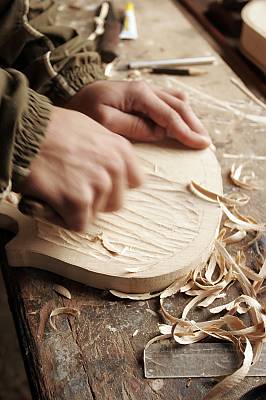Fandango’s Living Museum
Selected in 2011 on the Best Safeguarding Practices
Country(ies): Brazil
Identification
Description

- Fandango’s Living Museum
- © 2005 by Felipe Varanda - collection of the Fandango’s Living Museum
Fandango is a popular music and dance expression in coastal communities in southern and south-eastern Brazil. Fandango songs are called modas and are played with handmade instruments – viola, fiddle and frame drum. Traditionally, fandangos were offered as payment for collective activities, such as planting, harvesting and fishing. However, a decline in collective work has led to fandango losing its prestige and sense of identity: many representatives have died and new generations are indifferent to it. Fandango’s Living Museum was conceived to promote safeguarding actions for fandango as an important part of their cultural heritage. The initiative came from a non-governmental organization, Caburé Cultural Association. Approximately 300 local practitioners or fandangueiros have participated to create an open-air community museum and a circuit of visiting and exchanging experience, which includes houses of fandangueiros and musical instrument makers, cultural and research centres, and places for selling local handicrafts. The museum has promoted awareness-raising by organizing local performances, running workshops in partnership with schoolteachers, publishing books and CDs, creating a website, and making bibliographic and audiovisual collections available. The model is based on cooperation, and can be adapted for other cultural expressions and similar regional contexts, taking into account their local characteristics.
Documents
- Nomination form: English|French
- Consent of communities: English|Portuguese
Decision 6.COM 9.5
The Committee (…) decides that, from the information provided in the proposal, [this Programme] responds as follows to the criteria for selection in Paragraph 7 of the Operational Directives:
- P.1: The living museum project contributes to the continued practice of the fandango, strengthens interconnections between the communities, craftspeople, researchers, other members of local society and sustainable tourism, and enhances the viability of performance and transmission; it seeks to revitalize the practice of fandango while also enhancing the awareness of the locality as cultural space;
- P.2: The proposal describes a national and sub-national activity and makes little mention of regional or international cooperation;
- P.3: Based on the results obtained during its implementation and current actions, the living museum project demonstrates convergence with the Convention’s focus on raising awareness of the importance of the intangible cultural heritage and ensuring mutual appreciation thereof, fostering scientific and artistic studies, conducting educational and training programmes within the communities concerned, and promoting those communities’ widest possible participation in safeguarding;
- P.4: The project is an innovative initiative that revitalizes a threatened element in contemporary conditions, with demonstrated effectiveness in safeguarding intangible cultural heritage through a local partnership network that supports local communities’ self-management and contributes to the viability of the fandango;
- P.5: The living museum project has involved all concerned groups, including researchers and heritage bearers, during the process of coordination, mobilization, research, monitoring and teaching, and the free, prior and informed consent to the proposal from the communities concerned was demonstrated;
- P.6: The project is a good safeguarding model and an alternative to current practices of festivalization; it can serve as a sub-regional or regional model, including for elements shared by several countries, and can be implemented directly by the States Parties or in collaboration with regional institutions;
- P.7: The parties involved in the project, as well as the State Party, are willing to participate in disseminating the experience as a best practice, if selected;
- P.8: The project has demonstrated that the measures employed have depended upon the participation of bearers and enjoyed support from various entities and, together with the tangible results obtained by the programme, the possibility of assessing its results in different phases can be inferred;
- P.9: The basic model of the living museum may be applicable with adjustments and adaptations to local situations in other countries, including developing ones, as it also opens the possibility of providing means of income for the communities involved.
Selects Fandango’s Living Museum as a programme, project or activity best reflecting the principles and objectives of the Convention;
Invites the State Party to initiate efforts of cooperation towards implementing best practices at the regional and international level.











